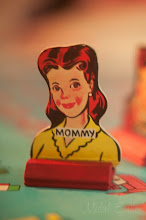
Don't let its looks fool you. This is a solid old chrome lens. I hope to get an adapter for my canon body and take photos like this soon! For now this will be a great tool for demonstrating aperture. Below are three different photos with three different aperture settings.



As you an see there is a considerable difference in the amount of light entering the camera at the different aperture settings(f 2.8, f 5.6, f 22).
Here is what changing the Aperture can do for you. Say we use the above lens at 2.8 and take a photo. It is allowing a lot of light to spill in the camera and expose the image on the sensor/film. Because so much light is coming in, the camera will need to use a faster shutter speed. Since the shutter speed is so fast the image is hitting the camera and disappearing very quickly. So what you are focused on, will be clear as a whistle, and anything in the foreground or background will become blurred. If we set the camera to use this lens at f/22 then you will find your shutter stays open a lot longer. In this case the image is falling on the film/sensor for a longer period of time and more of the image will be clear. Probably the entire scene.
Here are some images to show how changing the aperture affects the resulting image (click to enlarge):
 |
| From acceptable circle of confusion |
 |
| From acceptable circle of confusion |
 |
| From acceptable circle of confusion |
Do-doom (Jaws sound effect)
 |
| From acceptable circle of confusion |
 |
| From acceptable circle of confusion |
 |
| From acceptable circle of confusion |
Do-doom, do-doom, do-doom (Jaws -suspense building music)
 |
| From acceptable circle of confusion |
And there they go...
 |
| From acceptable circle of confusion |
I hope when you compare the Aperture setting in the photos you can see how the area in focus increases as you raise the Aperture. Also notice how much the shutter speed changed dramatically. Once you get the hang of things you can use that knowledge to your advantage too.
You can play with your aperture setting on your own camera. You don't have to know what to set the other numbers to. Today's cameras will choose that for you. So look in your manual for how to set your camera to Aperture Priority (this might be Av or A). Then play.
How do we know what aperture to set the camera at to capture a scene? It is really up to you. This is where you can become creative. The camera has to have the 'right' amount of light coming in the camera, the right balance of ISO, Shutter Speed, and Aperture to properly expose the sensor/film. You can shuffle the 'weight' among the three aspects. Once you learn what the different Apertures and Shutter Speeds can do for your image you just 'balance' the other two options to allow for your creative choice.
If you want to try the low apertures and love the look of a really blurry background (bokeh) then you might consider buying a cheap, but really good 'prime' lens. These lenses aren't zoom. You'll have to move yourself backward and forward to control what is in your photo. It really isn't a big deal. The cheapest way to go about this is buying a 50mm lens. You can buy them new from a place like BHphotovideo for right at $100. They are such a bargain!! You can browse some great 50mm work on the Nifty Fifty Flickr Group.
I'll discuss shutter speed at a future time. Here is further reading until then:
- Camera Demo This is really fun to play with. You can adjust this virtual camera's settings and see the changes it makes.
- Understanding Aperture
- Exposure
- Wiki Aperture





No comments:
Post a Comment